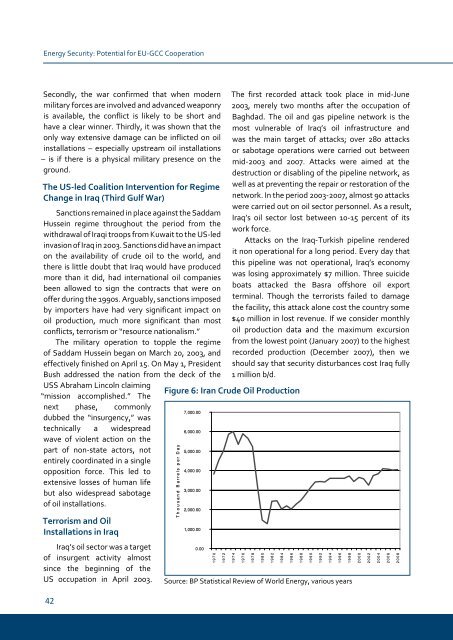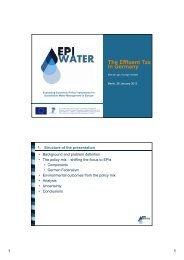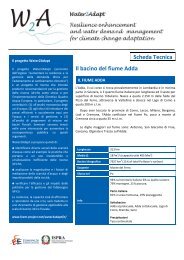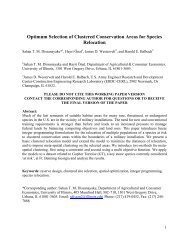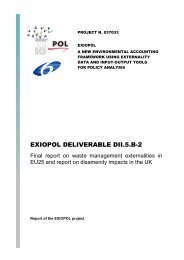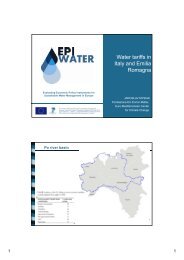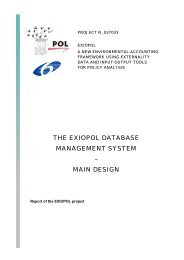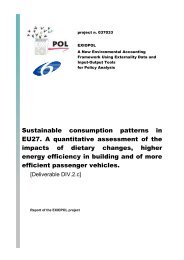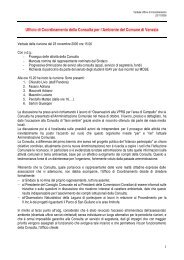Gulf and European Energy Supply Security - Feem-project.net
Gulf and European Energy Supply Security - Feem-project.net
Gulf and European Energy Supply Security - Feem-project.net
Create successful ePaper yourself
Turn your PDF publications into a flip-book with our unique Google optimized e-Paper software.
<strong>Energy</strong> <strong>Security</strong>: Potential for EU-GCC Cooperation<br />
Secondly, the war confirmed that when modern<br />
military forces are involved <strong>and</strong> advanced weaponry<br />
is available, the conflict is likely to be short <strong>and</strong><br />
have a clear winner. Thirdly, it was shown that the<br />
only way extensive damage can be inflicted on oil<br />
installations – especially upstream oil installations<br />
– is if there is a physical military presence on the<br />
ground.<br />
the Us-led Coalition Intervention for Regime<br />
Change in Iraq (third <strong>Gulf</strong> War)<br />
Sanctions remained in place against the Saddam<br />
Hussein regime throughout the period from the<br />
withdrawal of Iraqi troops from Kuwait to the US-led<br />
invasion of Iraq in 2003. Sanctions did have an impact<br />
on the availability of crude oil to the world, <strong>and</strong><br />
there is little doubt that Iraq would have produced<br />
more than it did, had international oil companies<br />
been allowed to sign the contracts that were on<br />
offer during the 1990s. Arguably, sanctions imposed<br />
by importers have had very significant impact on<br />
oil production, much more significant than most<br />
conflicts, terrorism or “resource nationalism.”<br />
The military operation to topple the regime<br />
of Saddam Hussein began on March 20, 2003, <strong>and</strong><br />
effectively finished on April 15. On May 1, President<br />
Bush addressed the nation from the deck of the<br />
USS Abraham Lincoln claiming<br />
“mission accomplished.” The<br />
next phase, commonly<br />
7,000.00<br />
dubbed the “insurgency,” was<br />
technically a widespread<br />
6,000.00<br />
wave of violent action on the<br />
part of non-state actors, not<br />
5,000.00<br />
entirely coordinated in a single<br />
opposition force. This led to<br />
4,000.00<br />
extensive losses of human life<br />
3,000.00<br />
but also widespread sabotage<br />
of oil installations.<br />
terrorism <strong>and</strong> oil<br />
Installations in Iraq<br />
Iraq’s oil sector was a target<br />
of insurgent activity almost<br />
since the beginning of the<br />
US occupation in April 2003.<br />
42<br />
2,000.00<br />
1,000.00<br />
0.00<br />
0<br />
7<br />
9<br />
1<br />
2<br />
7<br />
9<br />
1<br />
The first recorded attack took place in mid-June<br />
2003, merely two months after the occupation of<br />
Baghdad. The oil <strong>and</strong> gas pipeline <strong>net</strong>work is the<br />
most vulnerable of Iraq’s oil infrastructure <strong>and</strong><br />
was the main target of attacks; over 280 attacks<br />
or sabotage operations were carried out between<br />
mid-2003 <strong>and</strong> 2007. Attacks were aimed at the<br />
destruction or disabling of the pipeline <strong>net</strong>work, as<br />
well as at preventing the repair or restoration of the<br />
<strong>net</strong>work. In the period 2003-2007, almost 90 attacks<br />
were carried out on oil sector personnel. As a result,<br />
Iraq’s oil sector lost between 10-15 percent of its<br />
work force.<br />
Attacks on the Iraq-Turkish pipeline rendered<br />
it non operational for a long period. Every day that<br />
this pipeline was not operational, Iraq’s economy<br />
was losing approximately $7 million. Three suicide<br />
boats attacked the Basra offshore oil export<br />
terminal. Though the terrorists failed to damage<br />
the facility, this attack alone cost the country some<br />
$40 million in lost revenue. If we consider monthly<br />
oil production data <strong>and</strong> the maximum excursion<br />
from the lowest point (January 2007) to the highest<br />
recorded production (December 2007), then we<br />
should say that security disturbances cost Iraq fully<br />
1 million b/d.<br />
Figure 6: Iran Crude oil Production<br />
y<br />
a<br />
D<br />
r<br />
e<br />
p<br />
s<br />
l<br />
e<br />
r<br />
r<br />
a<br />
B<br />
d<br />
n<br />
a<br />
s<br />
u<br />
o<br />
h<br />
T<br />
4<br />
7<br />
9<br />
1<br />
6<br />
7<br />
9<br />
1<br />
8<br />
7<br />
9<br />
1<br />
0<br />
8<br />
9<br />
1<br />
Source: BP Statistical Review of World <strong>Energy</strong>, various years<br />
2<br />
8<br />
9<br />
1<br />
4<br />
8<br />
9<br />
1<br />
6<br />
8<br />
9<br />
1<br />
8<br />
8<br />
9<br />
1<br />
0<br />
9<br />
9<br />
1<br />
2<br />
9<br />
9<br />
1<br />
4<br />
9<br />
9<br />
1<br />
6<br />
9<br />
9<br />
1<br />
8<br />
9<br />
9<br />
1<br />
0<br />
0<br />
0<br />
2<br />
2<br />
0<br />
0<br />
2<br />
4<br />
0<br />
0<br />
2<br />
6<br />
0<br />
0<br />
2<br />
8<br />
0<br />
0<br />
2


